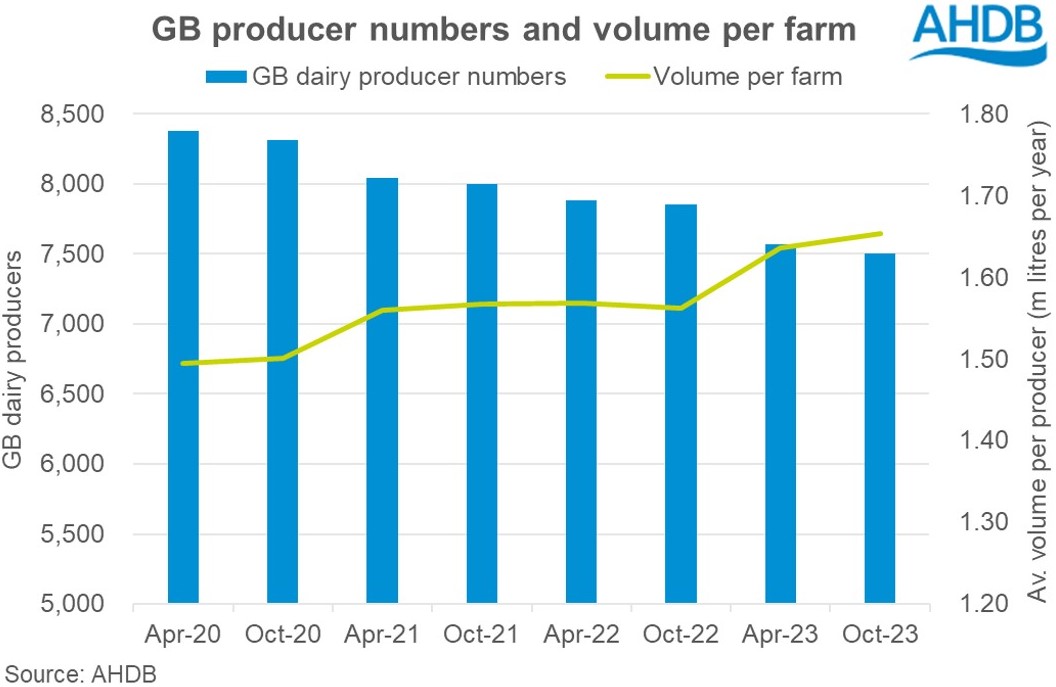GB producer numbers impacted by falling milk prices
Wednesday, 15 November 2023
Note: In the original article published on 15 November 2023 it stated there was no change compared to April. Due to a data revision on 23 November there is now a decline in GB producer numbers. We have amended the article accordingly.
In our latest survey of major milk buyers, it is estimated that there were 7,500 dairy producers in GB as of October 2023. Year on year, this is an estimated decline of 350 dairy producers (-4.5%) and a smaller decline of 70 producers (-0.9%) from our previous survey in April.
A major driver in the year-on-year decline has been the fall in farmgate milk prices. In September the Defra UK average milk price stood at 36.36ppl, a drop of almost 13ppl compared to the same month in 2022. Paired alongside this, despite inflationary pressure on key farm inputs easing, farm costs such as energy, fuel, feed and fertiliser remain historically high, with plenty of volatility in the markets. This has resulted in farm margins tightening.
Average milk production per farm has grown year on year but remains steady compared to volumes calculated in April this year. This indicates a shift towards larger farms.
In addition, with high milk prices in the latter part of 2022 many farms pushed their cows for increased yields to maximise benefits. However, as 2023 has progressed farms have been focused on improving efficiency and reducing on farm costs. Grass growth for the majority of the 2023 season sat above the previous season and the 5-year average, sustaining milk yields from grazing cows. In recent months, GB milk production has begun to ease with volumes in September and October down year on year by 1.3% and 2.7% respectively, a trend we forecast is likely to continue into the new season.

Historic data can be found on our producer numbers page.
Why do we carry out the survey?
Getting a true picture of the number of dairy producers in the country is often difficult due to the different reporting methods used.
- The Food Standards Agency (FSA) can be used to track producer numbers across England and Wales, based on the number of farmers registered to produce milk. However, deregistering is voluntary, and therefore unlikely to be top of the “to do” list for a farmer leaving the industry. The FSA will often only capture this cessation when a regular check is carried out. These checks occur on a 10-year basis (for those registered with Red Tractor) or a 2-year basis otherwise. This means FSA numbers will often over-state the number of dairy farmers in the country.
- Defra carry out a survey on the number of dairy holdings across the UK, which returns a figure considerably higher than our estimate. This is because it includes all farms with a dairy cow over 2 years old with offspring. Around a third of those holdings had fewer than 10 cows, meaning they are unlikely to be commercial dairy farms, and would be excluded from our estimate.
Notes
AHDB’s estimate represents the number of producers actively contributing to GB milk production. It is based on the number of active producers and temporary inactive producers from the milk buyers that contribute to the Daily Milk Deliveries survey. This covers approximately 82% of volumes in GB, and so the estimate has been adjusted accordingly.

Sign up to receive the latest information from AHDB.
While AHDB seeks to ensure that the information contained on this webpage is accurate at the time of publication, no warranty is given in respect of the information and data provided. You are responsible for how you use the information. To the maximum extent permitted by law, AHDB accepts no liability for loss, damage or injury howsoever caused or suffered (including that caused by negligence) directly or indirectly in relation to the information or data provided in this publication.
All intellectual property rights in the information and data on this webpage belong to or are licensed by AHDB. You are authorised to use such information for your internal business purposes only and you must not provide this information to any other third parties, including further publication of the information, or for commercial gain in any way whatsoever without the prior written permission of AHDB for each third party disclosure, publication or commercial arrangement. For more information, please see our Terms of Use and Privacy Notice or contact the Director of Corporate Affairs at info@ahdb.org.uk © Agriculture and Horticulture Development Board. All rights reserved.

